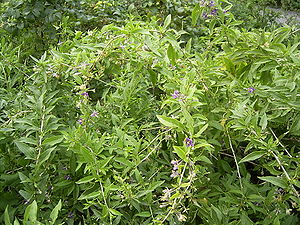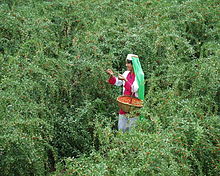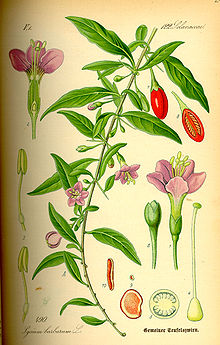Common wolfberry
| Common wolfberry | ||||||||||||
|---|---|---|---|---|---|---|---|---|---|---|---|---|

Common wolfberry ( Lycium barbarum ) |
||||||||||||
| Systematics | ||||||||||||
|
||||||||||||
| Scientific name | ||||||||||||
| Lycium barbarum | ||||||||||||
| L. |
The common wolfberry ( Lycium barbarum ) is a species of the genus of the wolfberry ( Lycium ) within the nightshade family (Solanaceae). In Central Europe it is a neophyte and is also called common wolfberry , common devil's twine , just devil's twine - not to be confused with the parasitic creeper devil's twine ( Cuscuta australis ) - or witch's twine or Chinese wolfberry . In China it is called Níngxià gǒuqǐ ( Chinese 寧夏 枸杞 / 宁夏 枸杞 - "Gouqi from Ningxia "). In Chinese, this name is also synonymous with wolfberry of high quality, as the best quality wolfberry grows in the Ningxia region of China, the berries of which are used in traditional Chinese medicine (TCM) as well as in Chinese cuisine .
In English-speaking countries, the berries of the common wolfberry, together with those of the Chinese wolfberry ( Lycium chinense ), are known as goji (goji berries) or Chinese wolfberry . It is used as an ornamental plant and is part of Chinese cuisine and traditional Chinese medicine. The EPPO code is LYUHA.
description
Vegetative characteristics
The common wolfberry is a deciduous shrub that reaches heights of 2 to 4 meters. Its rod-shaped, mostly prickly branches hang down like an arch. There are few slender thorns.
The short-stalked, slightly fleshy and (alternate) leaves sit individually or in groups on the branch. With a width of 1 to 2 centimeters and a length of 3.5 to 7 centimeters, the simple leaf blade is ovate to lanceolate, oblong, less often obovate and entire. The tip is rounded to mostly pointed.
Generative characteristics
The blooming time of the common wolfberry extends from June to August and partly to September. The axillary inflorescence contains one or more flowers. The flower stalk is 1 to 2 inches long.
The hermaphrodite flowers are five-fold with a double flower envelope . The calyx is bell-shaped with a diameter of 4 to 5 millimeters and somewhat two-lipped. The corolla is green-purple and funnel-shaped. The corolla tube is 8 to 10 millimeters long. The spreading corolla lobes are 5 to 6 millimeters long and almost bare at the edge. The ovary is on top, with a long stylus with a cephalic scar . The stamens and stylus sitting in the corolla tube protrude slightly above the corolla .
When ripe, the bright red or orange-yellow berries are elongated to ovoid with a length of 4 to 20 millimeters and a diameter of 5 to 12 millimeters. The fruits ripen from August to October. Each fruit contains 4 to 20 seeds. The brown-yellow, rounded and flattened seeds are about 1.5-2.5 millimeters in size.
The number of chromosomes is 2n = 24.
ecology
The common wolfberry is very hardy and can withstand frost down to −25 ° C. At the site, wolfberry spreads through roots ( rhizomes ) and is therefore limited by rhizome barriers. Cuttings from drooping branches are known as a way of spreading.
The pollination is effected by insects ( bees ) or self-pollination . The seeds are spread with the help of the animals that eat the fruit.
On the Wolfberry were caterpillars of the species tobacco hornworm , Manduca Quinquemaculata and skull hornworm observed. Powdery mildew in particular can be found on wolfberry. Lice of the genera Aphis and Paratrioza occur as pests, and occasionally snails.
Occurrence
According to Ellenberg , the common wolfberry is a full light plant. It occurs mainly in and near the cities in eastern Germany, overgrown on walls and fences. You see him less often in western Germany. It does not tolerate salt or heavy metals . Due to the frequent use for dam planting and as an ornamental plant , wolfberry occurs overgrown, especially in southern countries. In Europe it behaves invasively , which is why its planting in the open countryside can lead to undesirable displacement of native ruderal vegetation .

Origin and history
It is unclear where the real home of the wolfberry is. Its natural habitat can be found from southeast Europe to China . A typical wolfberry region in China is Ningxia. From there it spread as a cultivated plant to all of Asia , Europe , North America , North Africa and Australia / New Zealand . Others give only the Mediterranean area as the distribution area. The related species Lycium chinense , Lycium ruthenicum and Lycium turcomanicum are particularly widespread in Asia. The species Lycium pallidum is found in Central America and Lycium europaeum in the Mediterranean area to Portugal. The wolfberry is widespread in the northwestern Chinese provinces of Gansu , Ningxia , Qinghai and Inner Mongolia .
Systematics
The first publication of Lycium barbarum was in 1753 by Carl von Linné . Synonyms for Lycium barbarum L. are Lycium halimifolium Miller and Lycium vulgare Dunal .
Molecular biological studies confirm a strongly supported clade , which, in addition to the common wolfberry ( Lycium barbarum ), consists of Lycium ruthenicum and the Chinese wolfberry ( Lycium chinense ). The relationships between the three species and other ancient world species have not been clearly established.
Of Lycium barbarum there are two varieties:
- Lycium barbarum var. Auranticarpum K.F. Ching : This variety occurs only in China. The leaves are rather narrow and fleshy. There are only four to eight seeds in the orange-yellow fruits.
- Lycium barbarum L. var. Barbarum : The leaves are rather broad, thin or even paper-like. The number of seeds per fruit is higher than 15. The fruits are red in color.
use
kitchen
Wolfberry is used in China for cooking and natural medicine. In summer and autumn the fruits are harvested and dried in the sun. The fruits are cooked or, if they are sweet, eaten raw; some variants are very acidic. Leaves from young plants are also used as leafy vegetables.
Since other parts of the plant are not permitted as food in Europe, only the berry is processed here in the food industry . The fruit juice was initially offered by some manufacturers. The wolfberry, to which a particularly high proportion of so-called vital ingredients was attributed, was later marketed as a superfood under the name Goji . As a result, it became a trend food and more and more dried berries are being imported, although they often have strong pesticide residues . So were z. For example, all random samples from 2009 were highly contaminated with the insecticide acetamiprid , with more than ten other active ingredients being detected.
Since 2013, fresh fruits from European cultivation have also been offered, which can be frozen or stored in a dried state. The juice or fruits are used for mueslis, yoghurt or smoothies.
Ornamental plant
The wolfberry is also used as an ornamental plant.
Erosion control
Wolfberry is also used as a shrub to plant dams as protection against erosion .
Traditional Chinese medicine
In traditional Chinese medicine (TCM), dried wolfberry berries are used for high blood pressure and blood sugar , as well as for eye problems, to support the immune system and to prevent and treat cancer . As a single dose, 6 to 15 grams of the dried berries are given as decoction , in wine or as a tincture .
Traditionally, the Chinese have used goji berries to enhance yin . If there is a lack of Yin in the liver and kidneys, TCM has the following indications: drowsiness , diabetes mellitus , anemia , colds , exhaustion, impotence , fatigue, premature aging, night sweats , weakness in the back and knees, dizziness , tinnitus and poor eyesight , overexertion and Infertility .
pharmacology
Studies on effects
Various scientific and laboratory studies on postulated medical effects, in particular the ingredients zeaxanthin and lutein :
- Common wolfberry extracts are said to protect against destruction of the optic nerve if glaucoma is present.
- Polysaccharides from the plant have an immunomodulating effect.
- Aqueous extracts of common wolfberry have strong antioxidant properties , according to some studies .
There are no meaningful laboratory studies or clinical studies based on standard conditions on the effectiveness against cancer.
The European Food Safety Agency , EFSA, examined a number of studies that claimed that goji berries would protect the body's cells from free radicals and oxidative stress due to their antioxidant content, and concluded that the scientific evidence so far did not support this claim with certainty. According to the Federal Institute for Risk Assessment, there is no evidence of harmful effects of goji berries when consuming goji berries in normal quantities (50 g dried goji berries corresponding to approx. 66 mg zeaxanthin).
According to a statement by the head of the nutritional science institute at the University of Granada in 2010, the consumption of goji berries is just as "healthy" as the consumption of other types of fruit and vegetables; any other positive effects experienced after consumption can only be attributed to a placebo effect . Even in randomized , placebo-controlled, double-blind Chinese studies conducted up to 2010 , the physiological and clinico-chemical parameters remained unchanged.
Earlier assumptions that the wolfberry contained hyoscyamine go back almost without exception to a study from 1890 and have not been confirmed since then. Current pharmacological studies refute these statements.
Toxicity
There are no known cases of poisoning in humans. Therefore, wolfberry is not classified as poisonous. The toxicity described by Roth is based on an article from 1890, which, however, was refuted in 1891.
allergy
The fruit can cause allergies. There are various cross-reactions and a high potential for sensitization .
Interactions
Since the ingredients of the wolfberry react with cytochromes and thus influence the liver metabolism , drug interactions are possible. If vitamin K antagonists (e.g. Marcumar), which are used to thin the blood, are taken at the same time , the blood-thinning effect is increased. There is an increased risk of bleeding.
Web links
- Profile and distribution map for Bavaria . In: Botanical Information Hub of Bavaria .
- Common wolfberry . In: BiolFlor, the database of biological-ecological characteristics of the flora of Germany.
- Lycium barbarum L. In: Info Flora , the national data and information center for Swiss flora . Retrieved February 28, 2016.
- JS Miller and RA Levin: Lycium barbarum . In: Project Lycieae
- Thomas Meyer: Buckthorn data sheet with identification key and photos at Flora-de: Flora von Deutschland (old name of the website: Flowers in Swabia ).
Individual evidence
- ↑ a b c d e f g Lycium barbarum L., common wolfberry. In: FloraWeb.de.
- ^ A b H. Jäger: The ornamental trees of the gardens and parks: alphabetically ordered description, culture and use of all known wood plants and their varieties that can be grown outdoors in Germany from the same climate. Weimar, 1865, p. 299.
- ↑ Term “Ningxia gouqi (寧夏 枸杞 / 宁夏 枸杞) - Lycium barbarum Linnaeus”, Chinese / English: online at efloras.org, accessed on May 29, 2018.
- ↑ Lycium chinense / barbarum - Goji berry at Karlsruhe Institute of Technology, accessed on November 3, 2017.
- ↑ Helmut Pirc: Encyclopedia of wild fruit and rare fruit species. Leopold Stocker Verlag, 2015, ISBN 978-3-7020-1635-7 .
- ^ A b c John Gregory Hawkes: Lycium. : TG Tutin, VH Heywood, NA Burges, DM Moore, DH Valentine, SM Walters, DA Webb (Eds.): Flora Europaea . Volume 3: Diapensiaceae to Myoporaceae . Cambridge University Press, Cambridge 1972, ISBN 0-521-08489-X , pp. 194 (English, limited preview in Google Book search).
- ↑ a b c d e f Zhi-Yun Zhang, Anmin Lu, William G. D'Arcy: Solanaceae. : Lycium barbarum , p. 303 - online with the same text as the printed work , In: Wu Zheng-yi, Peter H. Raven (Ed.): Flora of China. Volume 17: Verbenaceae through Solanaceae , Science Press and Missouri Botanical Garden Press, Beijing and St. Louis 1994, ISBN 0-915279-24-X .
- ↑ Lycium barbarum in Manual of the Alien Plants of Belgium, under Herbarium specimen, accessed on September 5, 2019.
- ↑ a b Lycium barbarum on discoverlife.org, accessed September 5, 2019.
- ↑ a b c K. Lauber and G. Wagner: Flora Helvetica - No. 1546 Lycium barbarum L. 4th edition, 2007, ISBN 978-3-258-07205-0 , pp. 812-813.
- ^ Erich Oberdorfer : Plant-sociological excursion flora for Germany and neighboring areas . With the collaboration of Angelika Schwabe and Theo Müller. 8th, heavily revised and expanded edition. Eugen Ulmer, Stuttgart (Hohenheim) 2001, ISBN 3-8001-3131-5 , pp. 819 .
- ↑ a b c E. Toensmeier: Perennial vegetables: from artichoke to zuiki taro, a gardener's guide to over 100 delicious, easy-to-grow edibles. Chelsea Green Publishing, 2007, ISBN 978-1-931498-40-1 , pp. 186-187.
- ↑ GS Robinson et al .: HOSTS - a database of the hostplants of the world's Lepidoptera.
- ↑ a b c d Udo Pollmer : No miracle fruit - but life-threatening! . On April 1, 2016 at deutschlandfunkkultur.de , accessed on May 12, 2017.
- ↑ Dealing with invasive species ( Memento from July 16, 2017 in the Internet Archive ), p. April 25, 2008 at bfn.de , accessed on May 12, 2017 (PDF; 2.83 MB).
- ↑ a b c d Lutz Roth, Max Daunderer, Kurt Kormann: Toxic Plants - Plant Poisons. Occurrence, effect, therapy, allergic and phototoxic reactions. With a special section about poisonous animals. 5th expanded edition. Nikol, Hamburg 2008, ISBN 978-3-86820-009-6 , p. 475.
- ^ Lycium barbarum in the Germplasm Resources Information Network (GRIN), USDA , ARS , National Genetic Resources Program. National Germplasm Resources Laboratory, Beltsville, Maryland.
- ^ Rachel A. Levin et al .: Evolutionary Relationships in Tribe Lycieae (Solanaceae). In: DM Spooner, L. Bohs, J. Giovannoni, RG Olmstead, D. Shibata (eds.): Solanaceae VI: Genomics meets biodiversity. Proceedings of the Sixth International Solanaceae Conference , ISHS Acta Horticulturae 745, June 2007, ISBN 978-90-6605-427-1 . Pp. 225-239.
- ^ A b J. P. Hou: The Healing Power of Chinese Herbs and Medicinal Recipes. Haworth Integrative Healing Press, 2005, ISBN 0-7890-2202-8 , p. 152 ff.
- ↑ New and novel raw materials and food - Part 3 from "New Processes and Techniques in Food Production and Food Supply " , p. 41 April 2016 at bmgf.gv.at , accessed on May 12, 2017 (PDF; 3.61 MB) .
- ↑ Andreas Fischer: The new "miracle berries" are really that healthy . On May 15, 2011 from welt.de, accessed on May 12, 2017
- ↑ Management Report 2009 , p. 15, July 2010, on cvuas.de, accessed on May 12, 2017 (PDF; 1.21 MB).
- ↑ Goji berries are available for the first time as fresh fruit on the market . On June 4, 2013 at gojivital.com, accessed on May 12, 2017 (PDF; 171 kB).
- ^ AD Webster: Hardy Ornamental Flowering Trees and Shrubs. Kessinger Publishing, 2004, ISBN 1-4191-2283-5 . P. 87.
- ↑ a b S. Klenow, KP Latté, U. Wegewitz, B. Dusemund, A. Pöting, KE Appel, R. Großklaus, R. Schumann, A. Lampen (ed.): Risk assessment of plants and herbal preparations , p. 29, 2012, on bfr.bund.de , accessed on May 12, 2017 (PDF; 1.67 MB).
- ↑ HC Chan, RC Chang, A. Koon-Ching Ip, K. Chiu, WH Yuen, SY Zee, KF So: Neuroprotective effects of Lycium barbarum Lynn on protecting retinal ganglion cells in an ocular hypertension model of glaucoma. In: Exp. Neurol. Volume 203, 2007, pp. 269-273, PMID 17045262 .
- ↑ T. Heinze and H. Barsett (Eds.): Polysaccharides I: Structure, Characterization And Use. Springer, 2005, ISBN 3-540-26112-5 , p. 87.
- ↑ SJ Wu et al .: Antioxidant activities of some common ingredients of traditional Chinese medicine, Angelica sinensis, Lycium barbarum and Poria cocos. Phytother Res . 18 (12), 2004, pp. 1008-12. PMID 15742346 .
- ^ R. Moss: A Friendly Skeptic Looks At Goji Juice . From chetday.com. Retrieved May 12, 2017
-
↑ EU Register of nutrition and health claims made on foods. Retrieved on December 31, 2014 (English, enter “Lycium barbarum” in the search mask, the wording reads:
Claim: Contains antioxidant / s; Is a source of antioxidant / s. With antioxidant / s. Contributes to the cell protection against free radicals Can protect your cells and tissues from oxidation Can contribute to the total antioxidant capacity of the body , and: Reasons for non-authorization: […] assessed on the basis of the scientific evidence, this claimed effect for this food has not been substantiated ). - ↑ S. Klenow, KP Latté, U. Wegewitz, B. Dusemund, A. Pöting, KE Appel, R. Großklaus, R. Schumann, A. Lampen (Eds.): Risk assessment of plants and herbal preparations , p. 19– 40, 2012 at bfr.bund.de , accessed on May 12, 2017 (PDF; 1.67 MB).
- ↑ Las bayas de Goji contienen los mismos nutrientes de frutas y verduras y "un importante efecto placebo" . May 19, 2010 at 20minutos.es, accessed May 12, 2017
- ^ M. Adams et al .: HPLC-MS trace analysis of atropine in Lycium barbarum berries. In: Phytochem Anal . 17 (5), 2006, pp. 279-83, PMID 17019928 .
- ↑ D. Frohne, HJ Pfänder: Poisonous Plants: a handbook for doctors, pharmacists, toxicologists, biologists and veterinarians. 2nd edition, Blackwell Publishing, 2005, ISBN 1-874545-94-4 , p. 370.
- ↑ Jerónimo J. Carnés: Recently introduced foods as new allergenic sources: Sensitization to Goji berries (Lycium barbarum). In: Food Chem . Volume 137 (1-4), 2013, pp. 130-135, PMID 23200000 .
- ^ I. Flügge: Possible interaction between vitamin K antagonists and the goji berry? - Risk of INR increase and severe bleeding events. In: Bulletin on drug safety, information from BfArM and PEI , Federal Institute for Drugs and Medical Devices (BfArM, Bonn) and Paul Ehrlich Institute (PEI, Langen) (ed.), Edition March 1, 2013 ( PDF , accessed on 21. April 2013).



